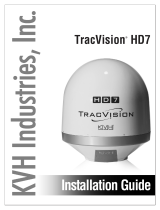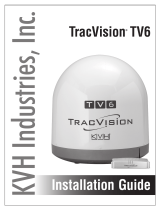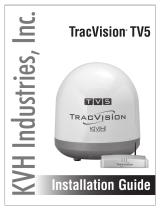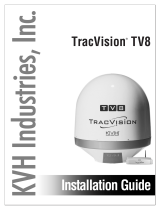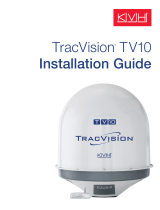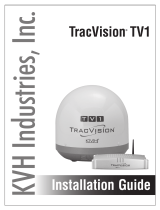Page is loading ...

Installation Guide
TracVision
®
HD7

AC Power and Grounding Requirements
1
Addendum
PLEASE READ!
Important Addendum to the Installation Guide
The KVH antenna system is AC powered, just like the other onboard
equipment to which it connects. Therefore, installing the system
requires careful examination of the AC power and grounding onboard
the vessel.
Figure 1 AC Power Options
KVH Antenna System
KVH Antenna System
Ground
50-120 VAC
Shipboard
Two-Phase,
Split-Phase,
or Delta Power
50-120 VAC
Leakage Current
KVH Antenna System
Shipboard
3-Wire
Single-Phase
AC Power
Ground
Neutral
N
100-240 VAC
OR
OR
Ground
Neutral
N
100-240 VAC
Single-Phase
Power Input
Ground Fault
Monitor
(when required)
Isolation Transformer
Ground
Ground
50-120 VAC
50-120 VAC
Shipboard
Two-Phase,
Split-Phase,
or Delta Power
54-0831 Rev. A

AC Power and Grounding Requirements
2
Addendum
AC Power Requirements
The KVH antenna system is designed to run on 3-wire single-phase
AC power (hot, neutral, and ground). Voltage between hot-neutral
and hot-ground should each measure between 100-240 VAC.
Many large ships use two-phase, split-phase, or delta power instead
(3 wires: hot, hot, and ground; no neutral). In this case, voltage
between hot-hot measures the proper voltage (100-240 VAC); while
hot-ground measures only half the voltage (50-120 VAC). Although
KVH antenna systems can operate on this type of power, the excess
voltage present on the second phase will cause a small amount of
current to leak onto ship's ground. This leakage current might be
unacceptable on some vessels. So be sure to check with the customer
or ship's electrician and get permission before you run the antenna
system on two-phase power. Also be sure to ground the system, as
explained on the next page.
If two-phase power is the only available power source onboard, and if
leakage current is unacceptable, KVH recommends that you install a
suitable isolation transformer to supply single-phase power to the
antenna system and run a ground wire from the transformer to ship's
ground. In addition, since ground fault protection devices cannot
detect faults behind a transformer, you will also need to install a
ground fault monitoring device between the isolation transformer and
the antenna system if ground fault protection is required on the vessel.

AC Power and Grounding Requirements
3
Addendum
Grounding Requirements
Proper grounding of the antenna system to ship's ground is critically
important, as it protects the equipment from lightning and
electrostatic discharges (ESD). Failure to ground the chassis of the
antenna's control unit risks damage to the antenna and electric shock.
In a standard installation with a connection to single-phase AC power,
the antenna system is normally connected to ship's ground through
the ground wire of the antenna control unit's power plug. As an
alternative, you may run a separate ground wire from the antenna
equipment's chassis to ship's ground, or mount the equipment within
a grounded equipment rack.
You are responsible for the quality and safety of the system’s
installation. Be sure that it meets these critical power and grounding
requirements.
WARNING
Failure to ground the antenna system properly to ship’s ground
will cause an unsafe floating ground condition, risking damage to
the antenna and electric shock, potentially resulting in DEATH.
In a floating ground condition, the difference between the
equipment’s chassis ground and the ship’s ground can measure
well over 100 volts, when it normally should not exceed 25 volts.
Therefore, always measure the difference in potential between
chassis ground and ship’s ground to make certain that there is no
dangerous floating ground condition, even if the ground pin of the
vessel’s AC power plug appears to be intact.

TracPhone HD7
1
Addendum
PLEASE READ!
Important Addendum to Your Product Manual
You may use the two 0.5" (12.5 mm) holes in the antenna frame (see
Figure 1) to hoist the antenna to its mounting location, if necessary.
DO NOT use any other structure inside the antenna — doing so might
damage the antenna.
Figure 1 Antenna Hoisting Holes
Hoisting Holes (x2)
54-0793 Rev. A

1
KVH, TracVision, and the unique light-colored dome with dark contrasting baseplate are registered trademarks of KVH Industries, Inc.
All other trademarks are property of their respective companies. The information in this document is subject to change without notice.
No company shall be liable for errors contained herein. © 2009-2011 KVH Industries, Inc., All rights reserved. 54-0662 Rev. E
These instructions explain how to install the TracVision HD7 satellite TV antenna system on a
vessel. Complete instructions on how to use the system are provided in the User’s Guide.
Installation Steps
Who Should Install the System?
To ensure a safe and effective installation, KVH recommends that a KVH-authorized marine
technician install the TracVision antenna. KVH-authorized technicians have the tools and
electronics expertise necessary to install the system. To find a technician near you, visit
www.kvh.com/wheretogetservice.
Technical Support
If you need technical assistance, please contact KVH Technical Support:
1. Inspect Parts and Get Tools ................. 3
2. Plan the Antenna Installation .............. 4
3. Plan the ACU Installation .................... 5
4. Determine RF Cable Requirements..... 6
5. Prepare the Antenna Site...................... 7
6. Remove the Restraints .......................... 8
7. Wire the Antenna .................................. 9
8. Mount the Antenna ............................. 11
9. Mount the ACU ................................... 12
10. Wire the ACU....................................... 14
11. Wire Supplied Components............... 15
12. Configure Each Receiver/DVR ......... 17
13. Connect the ACU to the Network..... 18
14. Update the Software if Necessary..... 22
15. Educate the Customer......................... 23
Phone: +1 401 847-3327
E-mail: [email protected]
(Mon.-Fri., 9 am - 6 pm Eastern)
(Sat., 9 am - 2 pm Eastern)
TracVision
®
HD7 Installation Guide

3
Before you begin, follow the steps below to
ensure you have everything needed to complete
the installation.
a. Unpack the box and ensure it contains
everything shown on the Kitpack Contents
List. Save the packaging for future use.
b. Carefully examine all of the supplied parts to
ensure nothing was damaged in shipment.
c. Gather the tools and materials listed below.
You will need these items to complete the
installation.
• #0 Flat-head screwdriver
• #1 Phillips screwdriver
• #2 Phillips screwdriver
• Electric drill and 1/2" (13 mm) bit
• 3" (80 mm) hole saw
• 5/8" open-end wrench
• 9/16" nut driver or wrench
• 7/16" open-end wrench
• Light hammer and center punch
• Wire strippers and terminal lug
crimper
•Cutting pliers
• RG-6 or RG-11 RF coax cabling with
Snap-N-Seal
®
F-connectors; refer to
Step 4 on page 6 for details
• Satellite TV receivers and/or DVRs
• Surge protector or uninterruptible
power supply (UPS) (recommended)
• Silicone sealant, self-vulcanizing tape,
or equivalent
Always lift the antenna by the baseplate and
never by the radome or any portion of the
internal antenna assembly (see Figure 1).
IMPORTANT!
Inspect Parts and Get Tools
1
Figure 1 TracVision HD7 Antenna
Figure 2 Antenna Control Unit (ACU)
Radome
Baseplate
CONTROL UNIT
MENU
CHANGE
ACCEPT
EXIT
ANTENNA
POWER
®
TRACKING SATS
DIRECTV 99-101-103

4
Before you begin, consider the following antenna
installation guidelines:
• The antenna must be mounted outside the
radar’s beam pattern.
• Minimize blockage. The antenna requires a
clear view of the sky to receive satellite TV
(see Figure 3). The fewer obstructions, the
better the system will perform.
• Make sure the mounting surface is wide
enough to accommodate the antenna’s base
(see Figure 4). Also make sure it is flat, level
(within ±1°), strong enough to support the
antenna’s weight (61 lbs (28 kg)), and rigid
enough to withstand vibration.
• Select a location that is as close as possible to
the intersection of the vessel’s fore-and-aft
centerline and midships.
• The antenna must be located within 100 ft
(30 m) of the ACU.
Do not mount the antenna at the same level as
the radar because the radar’s energy will
overload/damage the antenna’s LNB.
IMPORTANT!
Plan the Antenna Installation
Figure 3 Blockage from Obstruction
Figure 4 Antenna Dimensions
Antenna
Mast
Vessel Platform
Blocked!
15° to 75°
Look Angle
FWD
12"
[30.5 cm]
27.28"
[69.3 cm]
6"
[15.2 cm]
6"
[15.2 cm]
12"
[30.5 cm]
Ø.50"
[1.3 cm]
Ø26"
[66.6 cm]
2

5
Before you begin, consider the following ACU
installation guidelines:
• Select an ACU mounting location in a dry,
well-ventilated area belowdecks away from
any heat sources or salt spray.
• The ACU’s front panel should be easily
accessible to the user.
• Ensure the ACU mounting location provides
adequate WiFi reception. Do not install it in
an area surrounded by metal or near any
electrical devices that emit RF noise.
• The ACU must be located within 100 ft (30 m)
of the antenna.
• You can choose from two ACU mounting
options:
Option A - Equipment Rack Mounting
If desired, you can mount the ACU in a standard
19" (48.26 cm) equipment rack.
NOTE: The ACU is 1.5U in height.
Option B - Horizontal Surface Mounting
If desired, you can remove the rack-mount
brackets from the front panel of the ACU, and
secure the ACU underneath or on top of a
horizontal surface using the supplied horizontal
mounting brackets.
Plan the ACU Installation
Figure 5 ACU Dimensions
19.00"
[48.26 cm]
16.75"
[42.55 cm]
2.63"
[6.68 cm]
18.31"
[46.51 cm]
1.75"
[4.45 cm]
0.44"
[1.12 cm]
4X
11.18"
[28.40 cm]
1.52"
[3.8 cm]
1.02"
[2.60 cm]
4.81"
[12.22 cm]
Ø.25"
[0.64 cm]
3

6
Follow the instructions below to determine the
quantity and type of RF cables needed.
What Type of RF Cables are Needed?
To ensure optimal performance, refer to the table
below to select the required RF cable type for
your installation.
NOTE: Only use RF cable lengths 200 ft (60 m) or
shorter. One 100 ft (30 m) RG-11 RF cable is supplied
with the TracVision HD7 system.
How Many RF Cables are Needed?
The number of RF cables varies according to the
quantity of receivers and/or DVRs. Consider the
following guidelines.
• Since the 8-way splitter supports up to 8
tuners, you can connect any number of SWM
receivers/DVRs that adds up to 8 tuners or
fewer.
• Each receiver has a single tuner, and requires
one RF cable. Each DVR has two tuners, and
requires one RF cable.
• If you wish to support more than 8 tuners,
you can purchase a 16-tuner SWM Expander
Kit (KVH part #72-0452-01) or a 32-tuner
SWM Expander Kit (KVH part #72-0452-02).
What Type of RF Cable Connectors are
Needed?
Be sure to use only Snap-N-Seal F-type
connectors. Twist-on connectors and other low-
quality connector types degrade performance.
For Lengths Use RF Cable Type
Up to 100 ft (30 m) RG-6
100 ft (30 m) to
200 ft (60 m)
RG-11
Determine RF Cable
Figure 6 Wiring Overview
NOTE: Refer to “Wire Supplied Components” on
page 15 for complete SWM receiver/DVR connection
instructions. Refer to “Wiring Non-SWM Receivers”
on page 29 for complete non-SWM connection
instructions.
Vessel
AC Ground
SWM
(RF1)
Power
Data
Antenna
8-Way Splitter
ACU
CONTROL UNIT
MENU
CHANGE
ACCEPT
EXIT
ANTENNA
POWER
®
TRACKING SATS
DIRECTV 99/101/103
SWM
Power
Inserter
IRDSWM
Supports up to 8 Tuners
Each SWM Receiver = 1 Tuner = 1 RF Cable
Each SWM DVR = 2 Tuners = 1 RF Cable
RF
RF
RF
RF RF RF RF
RFRFRF
RF
=
RG-6/RG-11
RF Cable
Additional Cables Needed for
Non-SWM Receivers/DVRs
(DIRECTV Latin America,
DISH Network, Bell TV, and
Legacy DIRECTV Receivers)
RF2
RF3
4

7
Follow the steps below to drill the antenna’s
mounting holes and cable access hole.
a. Unfold the antenna mounting template
(supplied in the Customer Welcome Kit) and
place it onto the mounting surface. Make sure
the “FWD” (forward) arrow points toward
the bow and is parallel to the vessel’s
centerline (see Figure 7).
b. Using a light hammer and center punch,
mark the locations for the four mounting
holes and cable access hole on the mounting
surface in the locations indicated on the
template.
c. Drill a 1/2" (1.3 cm) hole at the four mounting
hole locations. Later, you will insert four
3/8"-16 bolts through these holes to secure
the antenna to the mounting surface.
d. Cut out the 3" (8 cm) hole at the cable access
hole location. Smooth the edges of the hole to
protect the cables. Later, you will route the
cables through this hole and into the vessel.
e. Clean and dry the antenna mounting surface.
f. Peel off the paper backing from the supplied
foam seal to expose the adhesive.
g. Press the foam seal down firmly onto the
mounting surface (not the antenna’s
baseplate), ensuring the hole in the foam seal
aligns with the cable access hole in the
mounting surface (see Figure 8).
NOTE: Apply the foam seal to the vessel mounting
surface, not to the antenna’s baseplate. You will have
difficulty connecting the cables to the antenna if the
foam seal is attached to the baseplate.
Prepare the Antenna Site
Figure 7 Antenna Mounting Holes Layout
Figure 8 Foam Seal
12"
(30.5 cm)
FWD
1/2" ( 1.3 cm)
Mounting Hole (x4)
12"
(30.5 cm)
3" ( 8 cm)
Cable Access Hole
Align with
Cable Access
Hole
5

8
Internal restraints prevent the antenna assembly
from moving during shipment. Follow these
steps to remove these shipping restraints.
NOTE: Be sure to keep the shipping restraint
hardware for future use.
a. Using a #2 Phillips screwdriver, remove the
six #10-32 Phillips screws securing the
radome to the baseplate (see Figure 9).
b. Carefully lift the radome straight up off the
antenna. Then set it aside in a safe place.
c. Using a 9/16" nut driver or wrench, remove
the four bolts, two brackets, and two washers
securing the antenna to the shipping pallet
(see Figure 10).
TIP: You will remove additional shipping restraints
after you mount the antenna.
Remove the Restraints
Figure 9 Radome Screws
Figure 10 Shipping Restraints
Screw (x6)
Radome
Baseplate
Bracket
and Bolt (x2)
Bolt and
Washer (x2)
6

9
Connect the Power and Data Cables
Connect and hand-tighten the data and power
cables to the antenna (see Figure 11). Then route
the cables belowdecks through the cable access
hole. Be sure to leave an adequate service loop,
approximately 8" (20 cm) of slack, in the cables
for easy serviceability.
Connect an RF Cable to SWM (RF1)
a. Connect an RF cable to the antenna’s SWM
(RF1) connector. Then, using a 7/16" open-
end wrench, tighten the RF cable for 1/4 turn.
b. Seal the RF cable connection with silicone
sealant, self-vulcanizing tape, or equivalent.
Wire the Antenna
Figure 11 Antenna Connectors
RF4
RF2
DATA
TO SWM
Power
Inserter
Non-SWM
Receivers
(DIRECTV Latin
America, DISH
Network, Bell TV,
and Legacy
DIRECTV
Receivers)
SWM
(RF1) RF3
POWER
7

10
Connect Additional RF Cables - Non-SWM
Receivers/DVRs Only
Follow the instructions below if you need to
connect non-SWM receivers/DVRs. Non-SWM
receivers/DVRs include DIRECTV Latin
America, DISH Network, Bell TV, and legacy
DIRECTV receivers. SWM-compatible receivers/
DVRs are listed below.
NOTE: Additional SWM-compatible receivers/DVRs
might become available at any time. If your receiver or
DVR model is not listed here, check the receiver’s/
DVR’s manual to see if it is SWM-compatible.
a. Connect RF cables to the antenna’s RF2 and
RF3 connectors (see Figure 12). Then, using a
7/16" open-end wrench, tighten the RF cables
for 1/4 turn.
b. Label the ends of the SWM (RF1), RF2, and
RF3 cables for easy identification later.
c. Seal the RF cable connections with silicone
sealant, self-vulcanizing tape, or equivalent.
d. Route the cables belowdecks through the
cable access hole. Leave an adequate service
loop, approximately 8" (20 cm) of slack, in the
cables for easy serviceability.
•HR20
•HR21
• HR21 Pro
•HR22
•HR23
•H20
•H21
•H22
•H23
•R16
•R22
•R23
•D12
•D13
Continued Wire the Antenna
Figure 12 Antenna Connectors
RF4
RF2
DATA
TO SWM
Power
Inserter
Non-SWM
Receivers
(DIRECTV Latin
America, DISH
Network, Bell TV,
and Legacy
DIRECTV
Receivers)
SWM
(RF1) RF3
POWER
7

11
Follow the steps below to mount the antenna to
the mounting surface.
a. Place the antenna baseplate over the holes
drilled in the mounting surface.
b. Ensure the forward arrow inside the
baseplate points toward the bow and is
parallel to the vessel’s centerline (see
Figure 13).
c. At each of the four baseplate mounting holes,
place a 3/8" fender washer on a 3/8"-16 bolt
and insert the bolt into the hole from above
(see Figure 14).
NOTE: To enable proper grounding, ensure the
shoulder washers are in place, and were not dislodged
during shipping restraint removal (see Figure 14).
d. Secure each mounting bolt to the mounting
surface using a 3/8" shoulder washer,
3/8" flat washer, a 3/8" lock washer, and a
3/8"-16 hex nut from below (see Figure 14).
e. Tighten all four bolts until the four rubber
feet on the baseplate are bottomed against the
mounting surface and the foam seal is fully
compressed. KVH recommends that you
tighten the bolts to between 12 and 16 ft-lbs
(16.2 and 21.7 N-m) of torque.
f.
Using cutting pliers, cut and remove the tie-
wrap and wire equipped with paper tags (see
Figure 15).
g. Reinstall the radome onto the antenna. Secure
the radome in place using the six #10-32
screws you removed in “Remove the
Restraints” on page 8.
h. Install a plastic screw cap (supplied in the kit)
over the six radome screws.
You will need to rotate the antenna assembly
by hand to see all four mounting holes. Rotate
the antenna assembly slowly to avoid
damaging the antenna.
IMPORTANT!
Mount the Antenna
Figure 13 Forward Arrow Location
Figure 14 Antenna Mounting
Figure 15 Shipping Restraints
3/8"-16 Bolt (x4)
3/8" Fender Washer (x4)
Rubber
Foot (x4)
Foam
Seal
Mounting
Surface
3/8" Flat Washer (x4)
3/8"-16 Hex Nut (x4)
Antenna
Baseplate
3/8" Lock Washer (x4)
Preinstalled
3/8" Shoulder Washer (x4)
3/8" Shoulder Washer (x4)
IMPORTANT
Wire
Tie-wrap
IMPORTANT
8

12
Follow the steps below to mount the ACU to a
standard 19" (482.6 mm) equipment rack or a
horizontal surface.
Option A - Equipment Rack Mounting
a. Align the four mounting holes on the front
panel of the ACU to the mounting holes on
the equipment rack (see Figure 16).
b. Secure the ACU to the equipment rack using
four M6 screws and washers (see Figure 16).
Mount the ACU
Figure 16 ACU Equipment Rack Mounting
Mounting
Hole (x4)
M6 Screw
and Washer (x4)
9

13
Option B - Horizontal Mounting
a. Using a #1 Phillips screwdriver, remove the
six screws securing the rack mounting
brackets to the sides of the ACU (see
Figure 17).
b. Using a #1 Phillips screwdriver, secure the
mounting brackets to the sides of the ACU in
the bracket orientation for your installation
(see Figure 18 or Figure 19). Then secure the
mounting brackets using four supplied #6-32
Phillips screws and #6 washers.
c. Using fasteners appropriate for the mounting
surface, secure the ACU to the mounting
surface using the four mounting bracket
holes.
Continued Mount the ACU
Figure 17 ACU Rack Mounting Bracket Removal
Figure 18 Horizontal Mounting Bracket Orientation
Figure 19 Horizontal Mounting Bracket Orientation
Rack Mounting
Bracket (x2)
Screw (x6)
Horizontal Mounting
Bracket (x2)
#6-32 Screw and
#6 Washer (x4)
Horizontal Mounting
Bracket (x2)
#6-32 Screw and
#6 Washer (x4)
9

14
Follow the steps below to wire the ACU.
a. Connect the antenna’s data cable wires to the
terminal strip connector (supplied in the
kitpack), as shown in Figure 20. Using a #0
flat-head screwdriver, tighten each terminal
screw to secure the wires in place.
b. Connect the antenna’s power cable wires to
the terminal strip connector, as shown in
Figure 20. Using a #0 flat-head screwdriver,
tighten each terminal screw to secure the
wires in place.
c. Press and lock the terminal strip connector
into place on the rear of the ACU (see
Figure 21).
d. Connect the ACU’s 120 VAC power cord to
the rear of the ACU (see Figure 21). Then
plug the cord into a UPS or surge protector.
e. Optional - If you plan to connect the ACU to
an onboard network using the supplied
Ethernet cable, connect it to the ACU’s
Ethernet port (see Figure 22).
Wire the ACU
Figure 20 Terminal Strip Connector
Figure 21 Terminal Strip/Power Supply
Figure 22 Ethernet Port
12 1110987612543
Not Used
Not Used
Red (+42V)
Power Cable
Black (Gnd)
Data Cable (Body Color/Strip Color)
Gry/Wht
Wht/Gry
Wht/Org
Org/Wht
Brn/Wht
Wht/Blu
Wht/Brn
Blu/Wht
12 1110987612543
Terminal
Screw (x12)
RS232
Wi-Fi
KVH and TracVision are registered
trademarks of KVH Industries, Inc.
Tested to comply
with FCC Standards
Meets requirements
ANTENNA
ETHERNET
AC INPUT
100-240V~
160W MAX
50/60 HZ
FUSE
3.15A
250V~
FAST ACTING
This device complies with Part 15 of the FCC rules. Operation is subject
to the following two conditions: (1) This device must not cause harmful
interence, and (2) This device must accept any interference received,
including interference that may cause undesired operation.
RISK OF ELECTRIC SHOCK
DO NOT OPEN
CAUTION
Red (+42V)
Black (Gnd)
Not Used
Wht/Gry
Gry/Wht
Wht/Org
Org/Wht
Not Used
Wht/Brn
Brn/Wht
Wht/Blu
Blu/Wht
Terminal
Board
120 VAC
Power
Cord
RS232
Wi-Fi
KVH and TracVision are registered
trademarks of KVH Industries, Inc.
Tested to comply
with FCC Standards
Meets requirements
ANTENNA
ETHERNET
AC INPUT
100-240V~
160W MAX
50/60 HZ
FUSE
3.15A
250V~
FAST ACTING
This device complies with Part 15 of the FCC rules. Operation is subject
to the following two conditions: (1) This device must not cause harmful
interence, and (2) This device must accept any interference received,
including interference that may cause undesired operation.
RISK OF ELECTRIC SHOCK
DO NOT OPEN
CAUTION
Red (+42V)
Black (Gnd)
Not Used
Wht/Gry
Gry/Wht
Wht/Org
Org/Wht
Not Used
Wht/Brn
Brn/Wht
Wht/Blu
Blu/Wht
ETHERNET
10

15
Follow the steps below to wire the power
inserter, which is required for all installations,
and the supplied 8-way splitter, which is only
required for DIRECTV service.
NOTE: Only SWM-compatible splitters may be used.
Connect and Mount the Power Inserter
a. Attach a Snap-N-Seal F-type connector to the
SWM (RF1) cable from the antenna. Then
connect the cable to the power inserter’s
SWM connector (see Figure 23).
b. Using fasteners appropriate for the mounting
surface, secure the power inserter to the
mounting surface.
Connect and Mount the Splitter
a. Using the screws supplied with the splitter,
secure the splitter to an appropriate
mounting surface.
b. Fasten one end of the 25 ft (30 m) ground
wire (supplied in the kitpack) to the splitter’s
grounding screw. Connect the other end of
the ground wire to a suitable AC ground (see
Figure 24).
c. Connect one end of an RF cable to the power
inserter’s IRD connector. Connect the other
end of the cable to the splitter’s In connector
(see Figure 24).
This section explains how to connect the
8-way splitter for DIRECTV SWM receivers/
DVRs only. If you need to install non-SWM
receivers/DVRs, refer to the wiring diagrams
in “Wiring Non-SWM Receivers” on page 29.
IMPORTANT!
Wire Supplied Components
Figure 23 Power Inserter Connection
Figure 24 8-Way Splitter Connection (DIRECTV Only)
From
SWM (RF1)
Connector
SWM
Power
Inserter
SWM
From Antenna’s
SWM (RF1) Connector
SWM
Power
Inserter
IRD
In
SWM
Vessel
AC Ground
8-Way Splitter
Terminator
11

16
Connect Receivers/DVRs to the Splitter
Now you need to connect the receivers and/or
DVRs to the splitter. Consider the following
connection guidelines before you begin:
• Refer to the basic wiring diagrams in
Figure 25 and Figure 26.
• Since the 8-way splitter supports up to 8
tuners, you can connect any number of SWM
receivers/DVRs that adds up to 8 tuners or
fewer.
• Each receiver has a single tuner, and requires
one RF cable. Each DVR has two tuners, and
requires one RF cable.
• If you need to connect more than 8 SWM-
compatible receivers or 4 DVRs (more than 8
tuners total) for DIRECTV HD service, install
a 16-tuner SWM Expander Kit (KVH part
#72-0452-01) or a 32-tuner SWM Expander Kit
(KVH part #72-0452-02). If you wish to
connect non-SWM receivers, refer to “Wiring
Non-SWM Receivers” on page 29.
• Connector labeling might vary between
receiver and DVR models. Refer to the User’s
Guide for your selected receivers/DVRs for
complete information.
• Always terminate any unused splitter
connectors with a supplied terminator (see
Figure 24 on page 15).
Continued Wire Supplied Components
Figure 25 Basic SWM Receiver Wiring Diagram
Figure 26 Basic SWM DVR Wiring Diagram
Vessel
AC Ground
8-Way Splitter
From Power
Inserter’s IRD
Connector
SATELLITE IN
(
S
WM-1)
S-VIDEO OUT
COMPONENT OUT
AUDIO O UT
VIDEO OUT
DIGITAL AUDIO
OUT OPTICAL
HDMI OUT
ETHERNET
PHONE JACK
USB
DIRECTV
H23 Receiver
Satellite In
(SWM-1)
Supports up to 7 Additional Tuners
Each SWM Receiver = 1 Tuner
Each SWM DVR = 2 Tuners
Vessel
AC Ground
8-Way Splitter
From Power
Inserter’s IRD
Connector
Leave 1 unused connector
for each DVR you connect
SATELLITE IN 1
(
S
WM-2)
SATELLITE IN 2
S-VIDEO OUT
COMPONENT OUT
AUDIO OUT
VIDEO OUT
DIGITAL AUDIO
OUT OPTICAL
HDMI OUT
ETHERNET
PHONE JACK
USB
DIRECTV
HR23 DVR
Satellite In 1
(SWM-2)
Supports up to 6 Additional Tuners
Each SWM Receiver = 1 Tuner
Each SWM DVR = 2 Tuners
11
/


